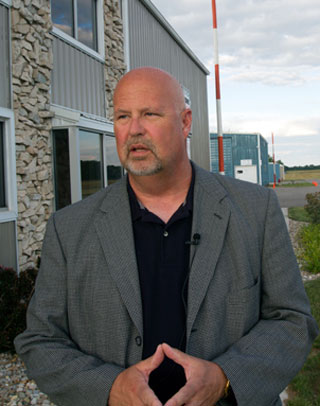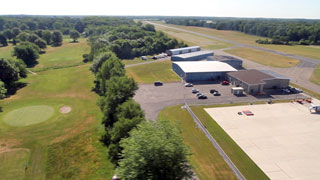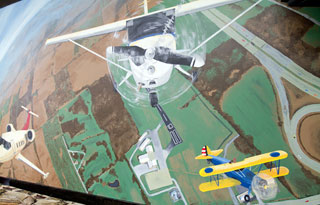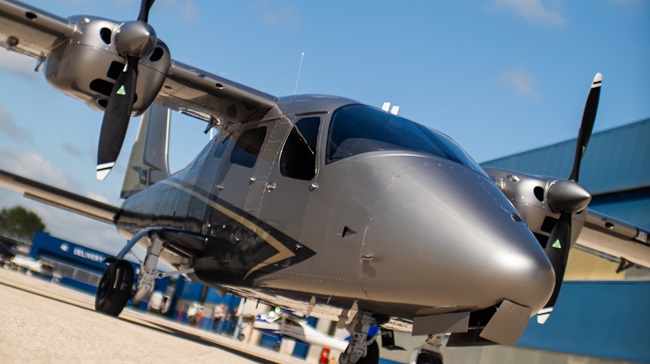Plymouth Municipal Airport might have closed for good, run-down and overgrown with weeds after 30 years of neglect. The 45-year-old municipal airport sits nearly in the heart of the town, encircled by two hotels (one with an adjacent restaurant), a golf course, a bank, and a Cadillac dealer.
 Plymouth, Ind., Mayor Mark Senter said the town has made an effort to make its municipal airport more appealing to both visitors and businesses.
Plymouth, Ind., Mayor Mark Senter said the town has made an effort to make its municipal airport more appealing to both visitors and businesses.
When Mayor Mark Senter was elected in 2008, he took an interest in the long-neglected airfield, and appointed new members to the Board of Aviation Commissioners, starting with Tom Flynn, who became president of the board.
“This airport had seen no improvements in 30 years, and I’m not exaggerating,” Flynn said, sitting in a lobby with a new tile floor and fresh paint on the walls—including a mural by local college student Kailee Shearin depicting three aircraft launching skyward, with the airport and a broad expanse of farmland and highway in the background. “Everything that you see here is new, and been redone recently by our new manager.”
Flynn and fellow board members first had to decide whether the airport, with a runway of 4,400 useable feet of cracked pavement, was worth saving.
“What do you do with an airport that the world thinks is dying and isn’t worth a nickel?” Flynn said. “We started doing a facelift.”
Manager Dave Lattimer, hired in 2010, got things moving. Crews mowed down the weeds that had hidden the runway from the view of cars passing close by on Michigan Road—the town’s thoroughfare. The town bought a sign to mark the airport (a first), and passersby have begun to notice.
“They can see the sign, now, because the ditch is cleaned up,” Lattimer said.
New siding was installed; hangar doors were updated with new lifting straps and motors; an FAA grant paid for crack sealing on the runway; new heating and air conditioning systems were installed; town crews poured a new sidewalk. Plans to resurface the runway—a major undertaking that is still being planned—were put on hold.
“We decided to concentrate on what we have already,” said Senter, who noted that the strategy has paid off. “Things have really taken off. We have three businesses out there now.”
One of those, Light Sport Repair Services, predates the revitalization, and owner Brian McCallen said the improvements have been most welcome. New heating and air conditioning make for much more comfortable working conditions, and the fresh coats of paint and other renovations make for a much better first impression.
 The municipal airport in Plymouth, Ind., is immediately adjacent to an 18-hole golf course.
The municipal airport in Plymouth, Ind., is immediately adjacent to an 18-hole golf course.
“This makes my customers a lot more comfortable when they come in,” McCallen said.
Two other businesses have moved in: Plymouth Sky Sports, a skydiving operator, and Fort Wayne Helicopters, where Ken Keller Jr. has launched an online training program to augment his income from dual instruction. The town hopes to attract a medevac helicopter and an expanded aviation program from nearby Culver Academies, the prep school formerly known as Culver Military Academy that produced aviator and author Ernest K. Gann among other notable alumni. The town is close to landing a GA repair shop to round out the on-field services.
The businesses are drawing people—and dollars—a fact not lost on the mayor and other officials who continue to work to promote and market the airport as a destination. Comparatively inexpensive fuel, and an 18-hole golf course right next door are drawing more GA pilots, including a Cirrus pilot who visited to play a round in early June and praised the quality of the course. Keller said other visitors occasionally wander in to his office.
“Six months ago that wasn’t happening,” Keller said. “That is pretty cool.”
The town has spent close to $100,000 on the various improvements, still holding more than $500,000 in long-accumulated reserve funding for future efforts including the runway overhaul. AOPA Great Lakes Regional Manager Bryan Budds said Plymouth offers an example other towns should follow.
 College art student and local resident Kailee Shearin painted a mural for the lobby in exchange for the promise of an airplane ride.
College art student and local resident Kailee Shearin painted a mural for the lobby in exchange for the promise of an airplane ride.
“In a time when far too many communities are questioning the importance of their community airport, the positive, proactive steps Plymouth is taking to invest in their airport and its ability to support the local economy cannot be understated,” Budds said. “Plymouth is a prime example of how local leaders and the aviation community can come together to support the area’s citizens.”
Red lights dot the roof of the Holiday Inn Express directly across the street from the approach end of Runway 10, and VOR/GPS instrument approaches guide pilots to either end of the runway—but Flynn said there’s a missing piece that will be critical to establishing medevac service here.
“AWOS we need from the FAA so badly we can’t even stand it,” Flynn said, noting the town rejected an offer for a less capable weather station fearing it would preclude installation of the AWOS (automated weather observation system) station required by LifeLine before a new base can be established at the airport.
“Everybody here is active, now, and wants the best for the community, the airport, and the county,” Flynn said. “We’re almost sold out of space. I don’t know of any other airport that’s booming like we are, and especially in the middle of north Indiana.”



